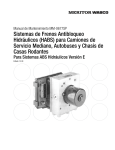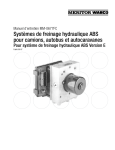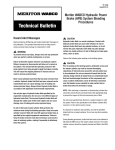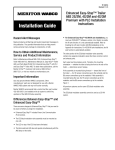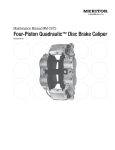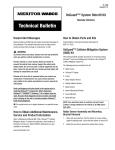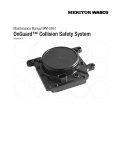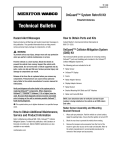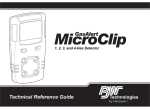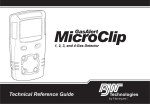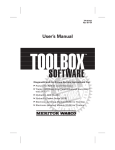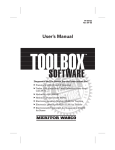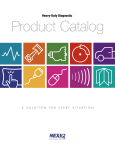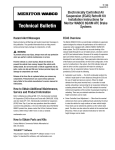Download Hydraulic Anti-Lock Braking Systems (HABS) for
Transcript
Maintenance Manual MM-0677 Hydraulic Anti-Lock Braking Systems (HABS) for Medium-Duty Trucks, Buses and Motor Home Chassis For E Version Hydraulic ABS Revised 06-11 Service Notes About This Manual This manual provides instructions for Meritor WABCO’s E Version hydraulic anti-lock braking system (HABS) for medium-duty trucks, buses and motor home chassis. Before You Begin 1. Read and understand all instructions and procedures before you begin to service components. 2. Read and observe all Warning and Caution hazard alert messages in this publication. They provide information that can help prevent serious personal injury, damage to components, or both. 3. Follow your company’s maintenance and service, installation, and diagnostics guidelines. 4. Use special tools when required to help avoid serious personal injury and damage to components. Hazard Alert Messages and Torque Symbols How to Obtain Additional Maintenance and Service Information On the Web Visit Literature on Demand at meritor.com to access and order product, service, aftermarket, and warranty literature for Meritor’s truck, trailer and specialty vehicle components. Meritor WABCO publications are also available on our website: meritorwabco.com Literature on Demand DVD (LODonDVD) The LODonDVD contains product, service and warranty information for Meritor and Meritor WABCO products. To order the DVD, visit Literature on Demand at meritor.com and specify TP-0742. How to Obtain Tools and Supplies Specified in This Manual Call Meritor’s Commercial Vehicle Aftermarket at 888-725-9355 to obtain Meritor tools and supplies. WARNING A Warning alerts you to an instruction or procedure that you must follow exactly to avoid serious personal injury and damage to components. CAUTION A Caution alerts you to an instruction or procedure that you must follow exactly to avoid damage to components. @ This symbol alerts you to tighten fasteners to a specified torque value. Information contained in this publication was in effect at the time the publication was approved for printing and is subject to change without notice or liability. Meritor WABCO reserves the right to revise the information presented or to discontinue the production of parts described at any time. Meritor WABCO Maintenance Manual MM-0677 (Revised 06-11) Contents pg. i 1 2 3 4 5 6 8 9 20 25 27 28 29 30 Asbestos and Non-Asbestos Fibers Section 1: Introduction Maintenance Manual Information Overview How Hydraulic ABS Works System Layout System Components Electronic Control Unit (ECU) Modulator Assembly Sensors ABS Warning Lamp TOOLBOX™ Software Section 2: Troubleshooting and Testing Maintenance General Information Wiring Diagrams System Wiring Information System Diagnostics Meritor WABCO TOOLBOX™ Software Blink Code Diagnostics Using Blink Code Diagnostics — Optional Feature Testing the System Meritor WABCO TOOLBOX™ Software E Version Hydraulic ABS Menus and Toolbars Standard Testing System Requirements and Component Tests Standard Component Testing Section 3: Component Replacement Component Removal and Installation Sensors Wheel Speed Sensor Replacement — Front Axle Wheel Speed Sensor Replacement — Rear Axle Electronic Control Unit (ECU) Modulator Assembly Brake Bleeding Procedures Pressure Fill and Bleed Asbestos and Non-Asbestos Fibers ASBESTOS FIBERS WARNING NON-ASBESTOS FIBERS WARNING The following procedures for servicing brakes are recommended to reduce exposure to asbestos ber dust, a cancer and lung disease hazard. Material Safety Data Sheets are available from ArvinMeritor. The following procedures for servicing brakes are recommended to reduce exposure to non-asbestos ber dust, a cancer and lung disease hazard. Material Safety Data Sheets are available from ArvinMeritor. Hazard Summary Hazard Summary Because some brake linings contain asbestos, workers who service brakes must understand the potential hazards of asbestos and precautions for reducing risks. Exposure to airborne asbestos dust can cause serious and possibly fatal diseases, including asbestosis (a chronic lung disease) and cancer, principally lung cancer and mesothelioma (a cancer of the lining of the chest or abdominal cavities). Some studies show that the risk of lung cancer among persons who smoke and who are exposed to asbestos is much greater than the risk for non-smokers. Symptoms of these diseases may not become apparent for 15, 20 or more years after the rst exposure to asbestos. Most recently manufactured brake linings do not contain asbestos bers. These brake linings may contain one or more of a variety of ingredients, including glass bers, mineral wool, aramid bers, ceramic bers and silica that can present health risks if inhaled. Scientists disagree on the extent of the risks from exposure to these substances. Nonetheless, exposure to silica dust can cause silicosis, a non-cancerous lung disease. Silicosis gradually reduces lung capacity and ef ciency and can result in serious breathing dif culty . Some scientists believe other types of non-asbestos bers, when inhaled, can cause similar diseases of the lung. In addition, silica dust and ceramic ber dust are known to the State of California to cause lung cancer . U.S. and international agencies have also determined that dust from mineral wool, ceramic bers and silica are potential causes of cancer. Accordingly, workers must use caution to avoid creating and breathing dust when servicing brakes. Speci c recommended work practices for reducing exposure to non-asbestos dust follow. Consult your employer for more details. Accordingly, workers must use caution to avoid creating and breathing dust when servicing brakes. Speci c recommended work practices for reducing exposure to asbestos dust follow . Consult your employer for more details. Recommended Work Practices 1. Separate Work Areas. Whenever feasible, service brakes in a separate area away from other operations to reduce risks to unprotected persons. OSHA has set a maximum allowable level of exposure for asbestos of 0.1 f/cc as an 8-hour time-weighted average and 1.0 f/cc averaged over a 30-minute period. Scientists disagree, however, to what extent adherence to the maximum allowable exposure levels will eliminate the risk of disease that can result from inhaling asbestos dust. OSHA requires that the following sign be posted at the entrance to areas where exposures exceed either of the maximum allowable levels: DANGER: ASBESTOS CANCER AND LUNG DISEASE HAZARD AUTHORIZED PERSONNEL ONLY RESPIRATORS AND PROTECTIVE CLOTHING ARE REQUIRED IN THIS AREA. 2. Respiratory Protection. Wear a respirator equipped with a high-ef ciency (HEP A) lter approved by NIOSH or MSHA for use with asbestos at all times when servicing brakes, beginning with the removal of the wheels. 3. a. Procedures for Servicing Brakes. Enclose the brake assembly within a negative pressure enclosure. The enclosure should be equipped with a HEPA vacuum and worker arm sleeves. With the enclosure in place, use the HEPA vacuum to loosen and vacuum residue from the brake parts. b. As an alternative procedure, use a catch basin with water and a biodegradable, nonphosphate, water-based detergent to wash the brake drum or rotor and other brake parts. The solution should be applied with low pressure to prevent dust from becoming airborne. Allow the solution to ow between the brake drum and the brake support or the brake rotor and caliper. The wheel hub and brake assembly components should be thoroughly wetted to suppress dust before the brake shoes or brake pads are removed. Wipe the brake parts clean with a cloth. c. If an enclosed vacuum system or brake washing equipment is not available, employers may adopt their own written procedures for servicing brakes, provided that the exposure levels associated with the employer’s procedures do not exceed the levels associated with the enclosed vacuum system or brake washing equipment. Consult OSHA regulations for more details. d. Wear a respirator equipped with a HEPA lter approved by NIOSH or MSHA for use with asbestos when grinding or machining brake linings. In addition, do such work in an area with a local exhaust ventilation system equipped with a HEPA lter . e. NEVER use compressed air by itself, dry brushing, or a vacuum not equipped with a HEPA lter when cleaning brake parts or assemblies. NEVER use carcinogenic solvents, ammable solvents, or solvents that can damage brake components as wetting agents. 4. Cleaning Work Areas. Clean work areas with a vacuum equipped with a HEPA lter or by wet wiping. NEVER use compressed air or dry sweeping to clean work areas. When you empty vacuum cleaners and handle used rags, wear a respirator equipped with a HEPA lter approved by NIOSH or MSHA for use with asbestos. When you replace a HEPA lter , wet the lter with a ne mist of water and dispose of the used lter with care. 5. Worker Clean-Up. After servicing brakes, wash your hands before you eat, drink or smoke. Shower after work. Do not wear work clothes home. Use a vacuum equipped with a HEPA lter to vacuum work clothes after they are worn. Launder them separately. Do not shake or use compressed air to remove dust from work clothes. 6. Waste Disposal. Dispose of discarded linings, used rags, cloths and HEPA lters with care, such as in sealed plastic bags. Consult applicable EPA, state and local regulations on waste disposal. Regulatory Guidance References to OSHA, NIOSH, MSHA, and EPA, which are regulatory agencies in the United States, are made to provide further guidance to employers and workers employed within the United States. Employers and workers employed outside of the United States should consult the regulations that apply to them for further guidance. Recommended Work Practices 1. Separate Work Areas. Whenever feasible, service brakes in a separate area away from other operations to reduce risks to unprotected persons. 2. Respiratory Protection. OSHA has set a maximum allowable level of exposure for silica of 0.1 mg/m3 as an 8-hour time-weighted average. Some manufacturers of non-asbestos brake linings recommend that exposures to other ingredients found in non-asbestos brake linings be kept below 1.0 f/cc as an 8-hour time-weighted average. Scientists disagree, however, to what extent adherence to these maximum allowable exposure levels will eliminate the risk of disease that can result from inhaling non-asbestos dust. Therefore, wear respiratory protection at all times during brake servicing, beginning with the removal of the wheels. Wear a respirator equipped with a high-ef ciency (HEP A) lter approved by NIOSH or MSHA, if the exposure levels may exceed OSHA or manufacturers’ recommended maximum levels. Even when exposures are expected to be within the maximum allowable levels, wearing such a respirator at all times during brake servicing will help minimize exposure. 3. Procedures for Servicing Brakes. a. Enclose the brake assembly within a negative pressure enclosure. The enclosure should be equipped with a HEPA vacuum and worker arm sleeves. With the enclosure in place, use the HEPA vacuum to loosen and vacuum residue from the brake parts. b. As an alternative procedure, use a catch basin with water and a biodegradable, nonphosphate, water-based detergent to wash the brake drum or rotor and other brake parts. The solution should be applied with low pressure to prevent dust from becoming airborne. Allow the solution to ow between the brake drum and the brake support or the brake rotor and caliper. The wheel hub and brake assembly components should be thoroughly wetted to suppress dust before the brake shoes or brake pads are removed. Wipe the brake parts clean with a cloth. c. If an enclosed vacuum system or brake washing equipment is not available, carefully clean the brake parts in the open air. Wet the parts with a solution applied with a pump-spray bottle that creates a ne mist. Use a solution containing water, and, if available, a biodegradable, non-phosphate, water-based detergent. The wheel hub and brake assembly components should be thoroughly wetted to suppress dust before the brake shoes or brake pads are removed. Wipe the brake parts clean with a cloth. d. Wear a respirator equipped with a HEPA lter approved by NIOSH or MSHA when grinding or machining brake linings. In addition, do such work in an area with a local exhaust ventilation system equipped with a HEPA lter . e. NEVER use compressed air by itself, dry brushing, or a vacuum not equipped with a HEPA lter when cleaning brake parts or assemblies. NEVER use carcinogenic solvents, ammable solvents, or solvents that can damage brake components as wetting agents. 4. Cleaning Work Areas. Clean work areas with a vacuum equipped with a HEPA lter or by wet wiping. NEVER use compressed air or dry sweeping to clean work areas. When you empty vacuum cleaners and handle used rags, wear a respirator equipped with a HEPA lter approved by NIOSH or MSHA, to minimize exposure. When you replace a HEPA lter , wet the lter with a ne mist of water and dispose of the used lter with care. 5. Worker Clean-Up. After servicing brakes, wash your hands before you eat, drink or smoke. Shower after work. Do not wear work clothes home. Use a vacuum equipped with a HEPA lter to vacuum work clothes after they are worn. Launder them separately. Do not shake or use compressed air to remove dust from work clothes. 6. Waste Disposal. Dispose of discarded linings, used rags, cloths and HEPA lters with care, such as in sealed plastic bags. Consult applicable EPA, state and local regulations on waste disposal. Regulatory Guidance References to OSHA, NIOSH, MSHA, and EPA, which are regulatory agencies in the United States, are made to provide further guidance to employers and workers employed within the United States. Employers and workers employed outside of the United States should consult the regulations that apply to them for further guidance. Meritor WABCO Maintenance Manual MM-0677 (Revised 06-11) i 1 Introduction Maintenance How Hydraulic ABS Works 1 Introduction Manual Information This manual contains service information for the Meritor WABCO E Version hydraulic ABS. For earlier versions of Meritor WABCO HABS, refer to: 앫 MM38 C Version HABS 앫 MM39 D Version HABS Copies of these manuals are posted on our website: ABS wheel sensors detect wheel speeds. The sensors generate signals that are transmitted to an ECU. If the wheels start to lock, the ECU signals the modulator assembly to regulate the brake pressure of each locking wheel. During an ABS stop, a solenoid valve in the modulator assembly is rapidly pulsed; that is, it opens and closes several times per second to control the brake pressure. When this occurs, drivers may notice a pulsation of the brake pedal. An ABS warning lamp on the vehicle instrument panel alerts the driver to a possible system fault and provides blink code information to diagnose the system. meritorwabco.com. Overview Meritor WABCO Hydraulic Anti-lock Braking System (HABS) is an electronic wheel speed monitoring and control system used on medium-duty trucks, buses and motor home chassis equipped with a hydraulic brake system. E Version HABS consists of an electronic control unit (ECU) mounted directly on a modulator valve. Typically, the modulator valve is mounted on the frame rail of the vehicle. Figure 1.1. If the ABS warning lamp comes on during normal vehicle operation, drivers may complete their trip, but are instructed to have their vehicle serviced as soon as possible. In the unlikely event of an ABS system malfunction, the ABS in the affected wheel will be disabled and will return to normal braking. The other sensed wheels may retain their ABS function. Do not rely on the ABS functioning for any of the sensed wheels. Have the vehicle serviced as soon as possible. Figure 1.1 4006333b Figure 1.1 Meritor WABCO Maintenance Manual MM-0677 (Revised 06-11) 1 1 Introduction System Layout A typical Meritor WABCO E Version HABS installation is illustrated in Figure 1.2. Figure 1.2 BRAKE BRAKE ABS WARNING LAMP MASTER CYLINDER HYDRAULIC BRAKE LINE HYDRAULIC BRAKE LINE ECU BRAKE SENSOR ASSEMBLY ABS MODULATOR ASSEMBLY BRAKE ABS SENSOR CABLE 1004682d Figure 1.2 The ABS modulator assembly must be mounted below the master cylinder and above the wheel cylinders. Figure 1.3 Meritor WABCO recommends that the motor axis makes an angle between +5° and +30° with the horizontal plane, with the motor end pointing up. Contact the OEM or Meritor WABCO for additional information regarding modulator orientation. System Components The following components make up Meritor WABCO E Version HABS. Electronic Control Unit (ECU) The electronic control unit (ECU) processes sensor signals and generates solenoid valve commands to reduce, maintain or reapply brake pressure. Figure 1.3. 4006333b Figure 1.3 2 Meritor WABCO Maintenance Manual MM-0677 (Revised 06-11) 1 Introduction Modulator Assembly Figure 1.5 CAUTION The modulator assembly contains brake fluid. Handle the modulator assembly with appropriate care. Do not expose the modulator assembly to impact loads or excessive vibrations. Do not blow compressed air into the hydraulic ports. Mishandling the modulator assembly may lead to component damage and system failure. 1004685a The modulator assembly houses the HABS solenoid control valves, one inlet valve and one outlet valve per wheel, a pump motor and two low pressure accumulators. Figure 1.4. Figure 1.5 Sensor Spring Clip 앫 Holds the wheel speed sensor in close proximity to the tooth wheel. Figure 1.6. Figure 1.4 Figure 1.6 1004686a Figure 1.6 4006345a Figure 1.4 Tooth Wheel 앫 A machined or stamped ring mounted to a machined surface on the hub of each ABS-monitored wheel. Figure 1.7. Sensors Figure 1.7 Sensor with Molded Socket 앫 Used to measure the speed of a tooth wheel rotating with the vehicle wheel. 앫 Produces an output voltage proportional to wheel speed. Figure 1.5. 1004687a Figure 1.7 Meritor WABCO Maintenance Manual MM-0677 (Revised 06-11) 3 1 Introduction Sensor Extension Cables Figure 1.10 앫 Two-wire cable with molded-on connector. Figure 1.8. 앫 Connects the wheel speed sensor to the ECU. Figure 1.8 4007045a Figure 1.10 NOTE: An RS232 to J1708 converter box is required. 1004688a The converter box and the program are available from SPX. Call 800-328-6657. Figure 1.8 ABS Warning Lamp 앫 Located on vehicle instrument panel. Figure 1.9. 앫 Alerts drivers to a possible system fault. 앫 Used by service personnel to display blink codes (optional feature). 앫 ABS warning lamp is not provided by Meritor WABCO. Figure 1.9 1004689a Figure 1.9 TOOLBOX™ Software 앫 A PC-based diagnostics program. 앫 Displays system faults and wheel speed data, tests individual components, verifies installation wiring and more. 앫 Runs in Windows® ME, XP, 2000 or Vista. Figure 1.10. 4 Meritor WABCO Maintenance Manual MM-0677 (Revised 06-11) 2 Troubleshooting and Testing Maintenance 2 Troubleshooting and Testing General Information There is no regularly scheduled maintenance required for Meritor WABCO E Version Hydraulic ABS. However, ABS does not change current vehicle maintenance requirements. For example, it is important that the vehicle brake fluid level be correctly maintained. Wiring Diagrams System Wiring Information Pin identification is shown in Figure 2.1. Wiring may vary according to the vehicle. Refer to the vehicle specifications for specific wiring diagrams. A typical Meritor WABCO Hydraulic ABS wiring diagram appears in Figure 2.2. Figure 2.1 PIN IDENTIFICATION FOR HABS WIRE HARNESS CONNECTORS TO THE ECU 27 31 16 26 15 1 (9511) Count from the pin number at the end of each row, identify pin assembly to measure. Connector view shows the back of the connector. Pin # Circuit Label 1 2 3 4 5 6 7 8 9 10 11 12 13 14 15 Ignition 12v 3rd Brake Relay (optional) Not Used Not Used Not Used Reference Ground Not Used Not Used Not Used Not Used Not Used Not Used Not Used J1939 + High – (optional) J1939 – Low – (optional) Pin # 16 17 18 19 20 21 22 23 24 25 26 27 28 29 30 31 Circuit Label Pump Motor Supply 12v+ Solenoid Valve Supply 12v+ Pump Motor Ground –Gnd Solenoid Valve Ground –Gnd Not used ABS Warning Lamp Relay Rear Right Wheel Speed Sensor Rear Left Wheel Speed Sensor Front Left Wheel Speed Sensor Front Right Wheel Speed Sensor J1587 Diag. B + Low Rear Right Wheel Speed Sensor Rear Left Wheel Speed Sensor Front Left Wheel Speed Sensor Front Right Wheel Speed Sensor J1587 Diag. A + High 4006172a Figure 2.1 Meritor WABCO Maintenance Manual MM-0677 (Revised 06-11) 5 2 Troubleshooting and Testing Figure 2.2 WIRING DIAGRAM HYDRAULIC ABS E-VERSION HABS WHEEL PRESSURE MODULATION SOLENOIDS PUMP– MOTOR FRONT LEFT FRONT RIGHT OV IV IV REAR LEFT IV OV REAR RIGHT IV OV OV ELECTRONIC CONTROL UNIT 31-PIN CONNECTOR 30A ** +12V 12V BATTERY FEED – 25A *** GND STUD 2 IGNITION SWITCH 5A 30 NOTES: Electric cables without marks: AWG 18 (SAE J 1128 TYP: TXL-CABLE) respectively 1 mm2 Blade type fuses corresponding to ISO/DIS 8820 Abbreviations: IV — Inlet Valve OV — Outlet Valve 31 26 14 15 29 25 30 23 28 22 27 CAN LOW 2x0.75 mm2 TWISTED 24 2x0.75 mm2 TWISTED 9 2x0.75 mm2 TWISTED 13 CAN HIGH ACC. SAE J1939 **** ABS WARNING LAMP GND STUD 1 + 2 2x0.75 mm2 TWISTED 21 DIAGNOSE "B" 20 DIAGNOSE "A" ACC. SAE J1587 6 OPTIONAL 12 DBR 1 OPTIONAL BLINK CODE SWITCH NORMAL CLOSED 19 REFERENCE GROUND 17 IGNITION 18 *SOLENOID VALVE GROUND 16 *SOLENOID VALVE SUPPLY 7 *PUMP MOTOR SUPPLY 5 *PUMP MOTOR GROUND 4 SENSOR FRONT LEFT SENSOR FRONT RIGHT SENSOR REAR LEFT SENSOR REAR RIGHT MATCHING THE MATING CONNECTOR ACCORDING TO DRAWING C953042 AMP P/N I-953042-6 (NO SHUNT) CODING: NUMBER 0 * Wire size AWG 12 (SAE J 1128 TYP: GXL-CABLE) Respectively Min. 3 mm2: Total resistance including crimp = 0.04 ohms. Corresponds to an overall length of 6 meters. ** According to SAE J 1284 or SAE J 1888. *** According to SAE J 1284. **** ABS lamp circuit (optional). 4006173d Figure 2.2 System Diagnostics Use Meritor WABCO’s PC-based diagnostic program, TOOLBOX™ Software, or standard blink codes to diagnose hydraulic ABS faults. Information for using standard blink codes appears in Table B in this section. Meritor WABCO TOOLBOX™ Software NOTE: For complete instructions for using this program, refer to the User’s Manual, TP-99102. Contact Meritor WABCO at 866-OnTrac1 (668-7221) for information about TOOLBOX™ Software. 6 Meritor WABCO Maintenance Manual MM-0677 (Revised 06-11) If you have TOOLBOX™ Software installed on your computer, use it to identify system faults. Then, follow the on-screen repair information to make the necessary repairs or replacements. To display Hydraulic ABS faults, use the pull-down menu or the HABS icon, Figure 2.3, to select HABS (Hydraulic ABS) from the Main Menu. The Hydraulic ABS Main Menu will appear. Figure 2.4. Select the View ECU Faults icon or select Display Faults to use the pull-down menu. Figure 2.5. This will display the Fault Information screen. Figure 2.6. 2 Troubleshooting and Testing Figure 2.3 Figure 2.5 1004697b Figure 2.5 Figure 2.6 1004695b Figure 2.3 Figure 2.4 1004698b Figure 2.6 The Fault Information screen contains a description of the fault. Repair instructions for each fault appear at the bottom of the screen. 4006577a Figure 2.4 Faults that occur after the screen is displayed will not appear until a screen update is requested. Use the Update button to refresh the fault information table. After making the necessary repairs, use the Clear Faults button to clear the fault. Use the Update button to refresh the fault information table and display the new list of faults. Most faults require an ignition cycle and/or test drive above 5 mph to verify fault resolution. Also check the ABS warning lamp to ensure the system functions correctly. Meritor WABCO Maintenance Manual MM-0677 (Revised 06-11) 7 2 Troubleshooting and Testing Blink Code Diagnostics Stored Fault: A condition that caused the system to register a fault, but is not currently active. For example, a loose wire that corrected itself. A stored fault can also be an active fault that has been corrected. Refer to Active Fault. Definitions ABS Warning Lamp: This lamp, located on the vehicle instrument panel, serves two purposes: 1. Table B, in this section, describes the method of distinguishing between active and stored faults and explains how to clear them. Alerts drivers or service personnel to a possible fault in the hydraulic ABS, as follows: System Code: Displaying identifier for supply voltage (12V) during system mode. Figure 2.7. IF the ABS warning lamp comes on briefly then goes OFF when the ignition is turned ON . . . . . there are no active faults in the hydraulic ABS Figure 2.7 IF the ABS warning lamp comes on and stays on AFTER the ignition is turned ON and NUMBER OF FLASHES ABS SYSTEM CODE 12V ECU The vehicle is driven in excess of four mph (6 km/h) . . . There may be an active fault in the hydraulic ABS 24V ECU IF the ABS warning lamp comes on and stays on and Goes OFF after the vehicle is driven in excess of four mph (6 km/h) or illuminates intermittently during driving . . . There may be a stored fault in the hydraulic ABS 2. Displays diagnostic blink codes for easy servicing. Blink Code: A series of blinks or flashes that describe a particular ABS system condition. Refer to Table B and Table C in this section for blink code identification. Blink Code Diagnostics: The ability of the Meritor WABCO ECU to sense faults in the ABS system and to define these faults via blink codes. Blink Code Switch: A momentary switch that activates blink code diagnostic capabilities. Usually, it is mounted under the instrument panel or on the steering column. Refer to the vehicle specifications for type and location. Clearing Fault Codes: The process of erasing faults from the ECU memory bank. Refer to Table B in this section. Fault Code: An ABS condition (fault) detected and stored in memory by the Meritor WABCO ECU and displayed by blink code. System faults may be Active or Stored. Active Fault: A condition that currently exists in the ABS system; for example, a sensor circuit malfunction on the left front steering axle. An active fault must be repaired before you can display additional faults. Once an active fault has been repaired, it becomes a stored fault. 8 Meritor WABCO Maintenance Manual MM-0677 (Revised 06-11) 4006959a Figure 2.7 2 Troubleshooting and Testing Using Blink Code Diagnostics — Optional Feature Follow the steps listed in Table B to use blink code diagnostics. Refer to Figure 2.15 and Figure 2.16 in this section for blink code illustrations. 1. Wiring Diagram (Figure 2.8) Figure 2.8 ECU IGNITION IGNITION ABS WARNING LAMP MONITOR BLINK CODE SWITCH (NORMALLY CLOSED) X21 ACTUATION 4006960a Figure 2.8 2. Activation of Blink Code Function — Optional Feature For activation, the blink code switch needs to be actuated for a variable length of time. The duration of the actuation determines the blink code mode. After the switch has been released again, the ABS warning lamp remains illuminated for 0.5 second to indicate the reception of a new blink code command from the user. 3. Termination of Blink Code Function — Optional Feature If either a system fault is detected or the blink code switch is depressed for more than 6.3 seconds, the current blink code command will be terminated immediately. If the diagnostic mode (output of fault codes via blinking the lamp) has been requested via blink code switch, and if there are no active faults stored inside the ECU (inactive faults only or no faults at all), the blink code is terminated as well after the fault codes have been blinked out once. Blink code is terminated if ignition is switched off and if the vehicle starts moving (vehicle speed greater than 2.5 mph or 4 km/h). If the blink code switch is held for 15 seconds or longer, an ABS warning lamp fault will be generated which also terminates the blink code. Meritor WABCO Maintenance Manual MM-0677 (Revised 06-11) 9 2 Troubleshooting and Testing 4. Blink Code Frequency (Figure 2.9) Figure 2.9 NORMAL BLINK FREQUENCY 0.5s ON 0.5s OFF FAST BLINK FREQUENCY 0.1s ON 0.2s OFF 4006961a Figure 2.9 5. Diagnostic Mode To activate the diagnostic mode, press the blink code switch for more than 0.5 second but less than 3.0 seconds. Figure 2.10. With active faults: Figure 2.10 > 0.5s < 3.0s 0.5s BLINK CODE SWITCH ON ABS WARNING LAMP FC1a 1.5s FC1b 1.5s 4s FC1a FC1b 1.5s 4006962a Figure 2.10 10 Meritor WABCO Maintenance Manual MM-0677 (Revised 06-11) 2 Troubleshooting and Testing FC1 is the fault code for the first active fault. a indicates the first part of the code. b indicates the second part. Table C. If a fault was detected during the current ignition switch cycle (an active fault), the corresponding fault code (FC1a and FC1b) is repeated continuously. If there are several active fault codes, only the most recent is displayed. The diagnostic mode is terminated if: 앫 The ignition switch is cycled. 앫 The vehicle starts moving and its speed exceeds 2.5 mph (4 km/h). 앫 The blink code switch is actuated for more than 6.3 seconds. With inactive faults: Figure 2.11. Figure 2.11 > 0.5s < 3.0s 0.5s BLINK CODE SWITCH ON ABS WARNING LAMP FC1a 1.5s FC1b 1.5s 4s FC2a FC2b 1.5s 4006963a Figure 2.11 FCn is the fault code for an inactive fault. a indicates the first part of the code. b indicates the second part. Table C. If there are no active faults, inactive fault codes will be displayed beginning with the most recent. When all inactive fault codes have been displayed, the diagnostic mode is terminated. 6. Clearing Faults (System) Mode This mode will be activated if the blink code switch is held for more than 3.0 seconds but less than 6.3 seconds. Within this mode, the faults stored in the ECU will be cleared. After clearing all faults, the ABS warning lamp blinks rapidly eight times. Figure 2.12. Faults will be cleared only if: 앫 There is no fault currently active. The system code will be displayed. Meritor WABCO Maintenance Manual MM-0677 (Revised 06-11) 11 2 Troubleshooting and Testing 앫 There are air gap faults or pole wheel faults stored in the ecu with an occurrence count of less than 50. If the occurrence count for both air gap and pole wheel faults is more than 50, the ecu is running in Sensitive mode which prevents fault code clearance. The system code will be displayed. NOTE: In Sensitive Mode, modified thresholds increase the speed with which faults are detected. 앫 The maximum on time of the abs inlet valves switches is not exceeded. The maximum on time is 1/3. The system code will be displayed continuously. When the faults are cleared, the system code is displayed continuously. Table A. Table A: System Code 1x 12V ECU AddOn E 2x 24V ECU AddOn E Two seconds after activating the system mode, endurance brake (retarder) reconfiguration can be requested by pressing the blink code switch three times for at least 0.5 second each at intervals of less than 3.0 seconds. Completion of reconfiguration will cause the ABS warning lamp to blink rapidly four times. The system mode will terminate if: 앫 The ignition switch is cycled. 앫 The vehicle starts moving and its speed exceeds 2.5 mph (4 km/h). 앫 The blink code switch is pressed for longer than 6.3 seconds. All faults will be cleared in system mode only if: 앫 There are no active faults. 앫 There are no sensor counts of 50 or greater. 앫 The maximum inlet valve actuation time was not exceeded. After clearing all faults, the ABS warning lamp blinks rapidly eight times followed by continuous repetition of the system code. Figure 2.12. 12 Meritor WABCO Maintenance Manual MM-0677 (Revised 06-11) 2 Troubleshooting and Testing Figure 2.12 > 3.0s < 6.3s 0.5s BLINK CODE SWITCH ABS WARNING LAMP ON 4s SYSTEM 4s SYSTEM 1.5s 4006964a Figure 2.12 Faults will not clear if: 앫 Active faults are detected. 앫 Stored faults have an occurrence count of 50 or more. 앫 Maximum inlet valve actuation time is exceeded. The system code will display continuously. Figure 2.13. Figure 2.13 > 3.0s < 6.3s 0.5s BLINK CODE SWITCH ON ABS WARNING LAMP SYSTEM 4s SYSTEM 4s SYSTEM 1.5s 4006965a Figure 2.13 7. Retarder Reconfiguration Reconfiguration occurs only if there are no active faults. Within system mode (after 2.0 seconds), request retarder reconfiguration by pressing the blink code switch three times for at least 0.5 second at intervals of less than 3.0 seconds. Figure 2.14. The ABS warning lamp blinks four times to confirm that the retarder has been reconfigured. Then, the system code displays continuously. Figure 2.14. Meritor WABCO Maintenance Manual MM-0677 (Revised 06-11) 13 2 Troubleshooting and Testing Figure 2.14 > 0.5s > 3.0s < 6.3s BLINK CODE SWITCH > 2s ON < 3s 4s SYSTEM ABS WARNING LAMP 4006966a Figure 2.14 14 Meritor WABCO Maintenance Manual MM-0677 (Revised 06-11) 2 Troubleshooting and Testing Table B: Identifying E Version Hydraulic ABS Blink Codes Troubleshooting with Blink Code Diagnostics — Optional Feature Mode Procedure System Response Action Diagnostics Step I. Possible responses: Turn ignition ON. 1. ABS warning lamp comes on momentarily then goes out, indicating System O.K. No recognizable active faults in the ABS. No action required. 2. ABS warning lamp does not light, indicating possible wiring fault or burned-out bulb. Inspect wiring. Inspect bulb. Make the necessary repairs. 3. ABS warning lamp stays on, indicating: Step II. Press and hold Blink Code Switch for one second, then release. Step III. Count the flashes to determine the blink code. 앫 Fault, or faults, in the system Continue with blink code diagnostics. Go to Step II. 앫 Sensor fault during last operation Continue with blink code diagnostics. Go to Step II. 앫 Faults cleared from ECU, but vehicle not driven. Drive vehicle — lamp will go out when vehicle reaches four mph (6 km/h). 앫 ECU disconnected. Connect ECU. ABS warning lamp begins flashing Determine if fault is active or stored: two-digit blink code(s). Active Fault: Lamp will repeatedly display one code. Stored Fault: Lamp will display code for each stored fault then stop blinking. Faults will be displayed one time only. First Digit: 1-14 flashes, Pause (1-1/2 seconds). Find definition for blink code on blink code chart. Second Digit: 1-11 flashes, Pause (4 seconds). Step IV. Active Fault. Make the necessary repairs. Turn ignition OFF. Stored Faults. Record for future reference. ABS warning lamp flashes eight times. All stored faults successfully cleared. Turn ignition OFF. Repair and record faults Clear Step V. Turn ignition ON. Clear faults from memory: Press and hold blink code switch for 3.0 to 6.0 Eight flashes not received. seconds, then release. Turn ignition ON. The warning lamp will stay on. This is because the ECU is looking for wheel speed. Drive the vehicle at a speed of four mph (6 km/h). Once the ECU senses wheel speed, the lamp will go off. Active faults still exist, repeat Step I through Step V. Meritor WABCO Maintenance Manual MM-0677 (Revised 06-11) 15 2 Troubleshooting and Testing Blink Codes Illustrated Figure 2.15 1 Second Hold Active Fault 1-14 Flashes 1-11 Flashes Pause Pause Pause Pause 1.5 s 1.5 s 4s 1.5 s 1st Digit (2) Light ON 2nd Digit (3) Continues until ignition is turned off Repeat of Blink Code (2) (3) Blink Code 2-3: Sensor Left Front – Airgap too large, fault number 3 (Refer to Table C). 1 Second Hold Off Stored Faults Pause Pause Pause 1.5 s 1.5 s 4s Light ON 1st Digit 2nd Digit 1st Stored Fault (5) (2) Displays all stored faults once – last fault stored is displayed first Pause 1.5 s 1st Digit 2nd Digit 2nd Stored Fault (3) (4) Blink Code 5-2: 3-4: 1 Second Hold Left Rear Sensor: Tire combination (mismatch), fault number 64 (Table C). Right Rear Sensor: Impedance problem, fault number 26 (Table C). System O.K. Pause Pause 1.5 s 1.5 s Light ON (1) Blink Code 1-1: System OK (1) S = Seconds 4007035a Figure 2.15 16 Meritor WABCO Maintenance Manual MM-0677 (Revised 06-11) 2 Troubleshooting and Testing Figure 2.16 3 Second Hold Note: After faults are cleared and vehicle is started, ABS lamp will stay on until vehicle is driven over 4 mph (6 km/h). Faults Cleared Pause Pause Pause Pause Pause 1.5 s 4s 4s 4s 4s Light ON System Code (1) 8 Quick Blinks = Faults Cleared System Code (1) System Code (1) Continues until ignition is turned off System Code (1) Code 1 3 Second Hold Faults Not Cleared (Active Faults Still Exist) Pause Pause Pause Pause 4s 4s 4s 4s Light ON System Code (1) System Code (1) System Code (1) S = Seconds Continues until ignition is turned off System Code (1) 4007034a Figure 2.16 E Version Hydraulic ABS Blink Codes Use the information in Table C to identify a fault and its fault number. The blink code appears in two parts. The first part identifies the faulty component. The second part identifies the location or the description of the fault. 1. Identify and record the blink code. Blink codes are identified in Columns 1 and 2. 2. Find the fault number in Column 3. Meritor WABCO Maintenance Manual MM-0677 (Revised 06-11) 17 2 Troubleshooting and Testing Table C: E Version Blink Codes First Part Second Part Fault Number 1 No Failure 1 No Failure — 2 Sensor: Air gap 1 Right Front 1 2 Sensor: Air gap 2 Left Rear 2 2 Sensor: Air gap 3 Left Front 3 2 Sensor: Air gap 4 Right Rear 4 3 Sensor: Impedance 1 Right Front 23 3 Sensor: Impedance 2 Left Rear 24 3 Sensor: Impedance 3 Left Front 25 3 Sensor: Impedance 4 Right Rear 26 4 Sensor: No trigger at all 1 Right Front 73 4 Sensor: No trigger at all 2 Left Rear 74 4 Sensor: No trigger at all 3 Left Front 75 4 Sensor: No trigger at all 4 Right Rear 76 5 Sensor: Tire Combination 1 Right Front 63 5 Sensor: Tire Combination 2 Left Rear 64 5 Sensor: Tire Combination 3 Left Front 65 5 Sensor: Tire Combination 4 Right Rear 66 6 Power Amplifier: Short to Ubat/Uvent 1 Right Front Inlet Valve 9 6 Power Amplifier: Short to Ubat/Uvent 2 Right Front Outlet Valve 10 6 Power Amplifier: Short to Ubat/Uvent 3 Left Front Inlet Valve 11 6 Power Amplifier: Short to Ubat/Uvent 4 Left Front Outlet Valve 12 6 Power Amplifier: Short to Ubat/Uvent 5 Right Rear Inlet Valve 13 6 Power Amplifier: Short to Ubat/Uvent 6 Right Rear Outlet Valve 14 6 Power Amplifier: Short to Ubat/Uvent 7 Left Rear Inlet Valve 15 6 Power Amplifier: Short to Ubat/Uvent 8 Left Rear Outlet Valve 16 6 Power Amplifier: Short to Ubat/Uvent 9 Engine Brake Relay 17 6 Power Amplifier: Short to Ubat/Uvent 10 Brake Light Relay 18 7 Power Amplifier: Open Circuit 1 Right Front Inlet Valve 27 7 Power Amplifier: Open Circuit 2 Right Front Outlet Valve 28 7 Power Amplifier: Open Circuit 3 Left Front Inlet Valve 29 7 Power Amplifier: Open Circuit 4 Left Front Outlet Valve 30 7 Power Amplifier: Open Circuit 5 Right Rear Inlet Valve 31 7 Power Amplifier: Open Circuit 6 Right Rear Outlet Valve 32 7 Power Amplifier: Open Circuit 7 Left Rear Inlet Valve 33 18 Meritor WABCO Maintenance Manual MM-0677 (Revised 06-11) 2 Troubleshooting and Testing Table C: E Version Blink Codes First Part Second Part Fault Number 7 Power Amplifier: Open Circuit 8 Left Rear Outlet Valve 34 7 Power Amplifier: Open Circuit 9 Engine Brake Relay 35 7 Power Amplifier: Open Circuit 10 Brake Light Relay 36 8 Power Amplifier: Short to Ground 1 Right Front Inlet Valve 41 8 Power Amplifier: Short to Ground 2 Right Front Outlet Valve 42 8 Power Amplifier: Short to Ground 3 Left Front Inlet Valve 43 8 Power Amplifier: Short to Ground 4 Left Front Outlet Valve 44 8 Power Amplifier: Short to Ground 5 Right Rear Inlet Valve 45 8 Power Amplifier: Short to Ground 6 Right Rear Outlet Valve 46 8 Power Amplifier: Short to Ground 7 Left Rear Inlet Valve 47 8 Power Amplifier: Short to Ground 8 Left Rear Outlet Valve 48 8 Power Amplifier: Short to Ground 9 Engine Brake Relay 49 8 Power Amplifier: Short to Ground 10 Brake Light Relay 50 9 Inlet Valve Actuation Time 1 Right Front 80 9 Inlet Valve Actuation Time 2 Left Rear 81 9 Inlet Valve Actuation Time 3 Left Front 82 9 Inlet Valve Actuation Time 4 Right Rear 83 10 Pump Motor 1 pm monitor voltage unexp. high 67 10 Pump Motor 2 pm monitor voltage unexp. low 68 10 Pump Motor 3 motor does not turn 69 10 Pump Motor 4 no pm supply voltage 70 10 Pump Motor 5 pm relay does not switch on 71 10 Pump Motor 6 pm relay does not switch off 72 11 J1939 1 Internal 77 11 J1939 2 bus failure 78 11 J1939 3 message failure 79 12 Pole Wheel 1 Right Front 84 12 Pole Wheel 2 Left Rear 85 12 Pole Wheel 3 Left Front 86 12 Pole Wheel 4 Right Rear 87 13 Brake Chatter 1 Right Front 90 13 Brake Chatter 2 Left Rear 91 13 Brake Chatter 3 Left Front 92 13 Brake Chatter 4 Right Rear 93 14 System 1 valve relay can’t switch off 55 Meritor WABCO Maintenance Manual MM-0677 (Revised 06-11) 19 2 Troubleshooting and Testing Table C: E Version Blink Codes First Part Second Part Fault Number 14 System 2 valve relay can’t switch on 56 14 System 3 reference ground connection 57 14 System 4 tire parameter not correct 58 14 System 5 ABS warning light bulb 59 14 System 6 brake warning light bulb 60 14 System 7 High Voltage 61 14 System 8 Low Voltage 62 14 System 9 Clamp 88 14 System 10 Pull Up Down 89 14 System 11 Internal Error 0 Testing the System This section of the manual contains information for testing the hydraulic ABS with TOOLBOX™ Software, as well as procedures for conducting standard air and electrical tests. NOTE: TOOLBOX™ Software must be connected to the vehicle and the vehicle ignition must be ON in order to display information. NOTE: For complete instructions for using this program, refer to the User’s Manual, TP-99102. Contact Meritor WABCO at 866-OnTrac1 (668-7221) for information about TOOLBOX™ Software. WARNING To prevent serious eye injury, always wear safe eye protection when you perform vehicle maintenance or service. Exhaust gas contains poison. When testing a vehicle with the engine running, test in a well-ventilated area or route the exhaust hose outside. To avoid serious personal injury, keep away, and keep test equipment away, from all moving or hot engine parts. Refer to, and follow, the vehicle manufacturer’s Warnings, Cautions and Service Procedures. E Version Hydraulic ABS Menus and Toolbars Select Hydraulic ABS from the TOOLBOX™ Main Menu. TOOLBOX™ senses the type of ECU being used and displays the HABS Main Screen. Main Screen This screen provides icons and pull-down menu task selections. It also provides information about the current status of Meritor WABCO HABS. Figure 2.17. Figure 2.17 When testing, set the parking brake and place the gear selector in NEUTRAL (manual transmission) or PARK (automatic transmission) unless otherwise directed. Meritor WABCO TOOLBOX™ Software Use TOOLBOX™ Software to verify the activation of various system components: 앫 Turn valves, pump and retarder relay on and off (Valve Activation Menu). 앫 Turn ABS warning lamp on and off (Miscellaneous Output Activation Menu). 4006726a Figure 2.17 20 Meritor WABCO Maintenance Manual MM-0677 (Revised 06-11) 2 Troubleshooting and Testing ECU information is read once from the ECU and does not change. All other information (e.g., wheel sensors, voltages and fault information) is read and updated continuously. Display Select Display from the HABS Main Screen. A pull-down menu will appear. Figure 2.18. The Fault Information screen contains a description of each fault, including the type of fault (Active or Stored), number of occurrences, SID and FMI number. Repair instructions for the fault appear at the bottom of the screen. Faults that occur after the screen is displayed will not appear until a screen update is requested. Use the Update button at the bottom of the screen to refresh the fault information table and display a new list of faults. Figure 2.18 After making any required repairs, use the Clear Faults button to clear the fault. Clear each fault as it is repaired. Cycle the ignition after clearing the faults. Use the Save or Print button to save or print the fault information data. Select Exit to close this section. Wheel Speed Select Wheel Speed to display the Wheel Speed screen. Figure 2.20. Figure 2.20 4004459c Figure 2.18 Faults Select Faults to display the Fault Information screen. Figure 2.19. 4004461a Figure 2.19 Figure 2.20 Use the Wheel Speed screen to verify that sensors are connected at each wheel. Speed at a sensed wheel (FL, FR, RL, RR) indicates sensors are installed, but does not verify correct sensor installation. 4004460b Figure 2.19 Meritor WABCO Maintenance Manual MM-0677 (Revised 06-11) 21 2 Troubleshooting and Testing Counters Miscellaneous Outputs Select Counters to display the Counters screen. Figure 2.21. Select Miscellaneous Outputs to display the Actuate Miscellaneous Outputs test screen. Figure 2.23. Figure 2.21 NOTE: Use TOOLBOX™ Software to test the following components: Retarder Relay, Brake Light Relay, Supply Valve, Cut-Off Valve, ABS Lamp, Traction Lamp, Brake Warning, Pump Front, Pump Rear, Buzzer. Figure 2.23 4004462b Figure 2.21 The Counters screen provides an overview of HABS component performance (pump hours, brake events, etc.) as well as general vehicle activity such as ignition cycles. Occurrences displayed on this screen accumulate until the Clear button is selected. Component Tests Select Component Tests from the HABS Main Screen. A pull-down menu will appear. Figure 2.22. 4005142b Figure 2.23 This screen provides a check of several HABS components, as well as a way to check either inlet or outlet activity of the valves, pump or retarder relay. Figure 2.22 Highlight the component you wish to test, then select the Send button to actuate the component. Component activation status appears in the Status Box field. Select Close to exit this screen. 4004463b Figure 2.22 22 Meritor WABCO Maintenance Manual MM-0677 (Revised 06-11) 2 Troubleshooting and Testing Valves Lamps Select Valves to display the Valve Activation test screen. Figure 2.24. Select Lamps to display the Lamp Test screen. Figure 2.25. Figure 2.25 Figure 2.24 4004465b Figure 2.25 As each lamp is tested, check the actual lamp to verify correct operation. Select Close to exit this screen. 4004464a Figure 2.24 The Valve Activation test screen lets you activate the HABS valves to check for correct activation and to verify correct brake line installation. Click on the valve you wish to test, then click the Send button to actuate the component. Component activation status appears in the Status box field. Select Close to exit this screen. Meritor WABCO Maintenance Manual MM-0677 (Revised 06-11) 23 2 Troubleshooting and Testing Relay Engine Data Link Select Relay to display the Activate Relay test screen. Figure 2.26. Select Engine Data Link to display the Data Link test screen. Figure 2.27. Figure 2.26 Figure 2.27 4004468a Figure 2.27 This screen allows you to send a “limit engine torque” command to the engine or a “disable retarder” command to the retarder. Select the data link destination (engine or retarder), then select Send to test. Use the Stop button to end testing. Select Close to exit this screen. Reset Memorized 4004467a Figure 2.26 This screen allows you to turn the retarder relay on or off. This is helpful in verifying correct operation, installation and wiring of the unit under test. Select Close to exit this screen. This is an automatic default and cannot be de-selected. It indicates the ECU has memorized the installed retarder relay. Once the ECU has seen a retarder, it expects to see it every time the vehicle is powered up. Figure 2.28. Because there are times when an ECU is moved to another vehicle — or during diagnostic testing — you may want the ECU to disregard this learned component. Use the Reset Memorized command for this purpose. Select Component Tests from the Hydraulic ABS Main Menu. Then, select Reset Memorized from the pull-down menu to reset the Learned Component screen. Figure 2.29. Figure 2.28 1004704a Figure 2.28 24 Meritor WABCO Maintenance Manual MM-0677 (Revised 06-11) 2 Troubleshooting and Testing 앫 Pins 16 to 18 Figure 2.29 앫 Pins 17 to 19 앫 Pins 1 to 6 Standard Component Testing ABS Warning Lamp 1004705b Figure 2.29 Standard Testing Test Equipment: Volt-Ohm Meter (VOM) Use of a VOM with automatic polarity sensing is recommended. This eliminates the concern of the polarity of the meter leads during voltage measurements. If the ABS warning lamp does not come on after the ignition is turned on, or it comes on but does not go out after three seconds, check all ABS fuses or circuit breakers and replace if necessary. Check the wiring to the ABS diagnostic switch and the warning lamp and repair or replace the wiring as required. When checking the warning lamp, follow these steps: 1. Check voltage potential at the lamp socket. 2. Check continuity of the wires to the socket. 3. Replace the bulb. NOTE: A complete wiring diagram for 4S/4M D Version hydraulic ABS appears in Figure 2.2 in this section. System Requirements and Component Tests Tire Size Range ABS Blink Code Switch For correct hydraulic ABS operation, front and rear tire sizes must be within 16% of each other. When testing the ABS diagnostic switch, perform the following. Contact the Meritor WABCO Customer Support Center at 866-OnTrac1 (668-7221) if you plan a tire size difference greater than 8%. 1. Check the resistance between the terminals while cycling the switch. A lack of continuity is an indication of a faulty switch. 2. Check the continuity of the wires to the switch: Pins 21 and 6 on the 31-pin harness Calculate the tire size with the following equation: % Difference = (RPM Steer/RPM Drive)−1 x 100 RPM = tire revolutions per mile CAUTION When troubleshooting or testing the ABS system, do not damage the connector terminals. Damaged connector terminals may cause system malfunction. Sensor Adjustment On steering axles, the sensor is typically accessible on the in-board side of the steering knuckle. On drive axles, the sensor is typically accessible on the in-board side of the rear axle spindle. To adjust the sensor, push the sensor in until it contacts the tooth wheel. Voltage Check 앫 Do not pry or push sensors with sharp objects. Voltage must be between 9.5 and 14 volts for the 12-volt hydraulic ABS to function correctly. 앫 Sensors will self-adjust during wheel rotation. Check voltage as follows. 1. Turn ignition ON. 2. Check for the correct voltage. NOTE: No gap is allowable at installation. During normal operation, a gap not to exceed 0.04-inch is allowable. Meritor WABCO Maintenance Manual MM-0677 (Revised 06-11) 25 2 Troubleshooting and Testing Sensor Output Voltage Test Sensor Resistance Sensor output voltage must be at least 0.2 volt AC at 30 rpm. Test the sensor output voltage as follows: The sensor circuit resistance must be between 900 and 2000 ohms. Measure resistance at the sensor connector, or at the pins on the ECU connector, as follows. 1. Turn ignition OFF. 2. Disconnect the ECU to measure voltage at the pins on the ECU connector. Refer to Table D. 1. Turn ignition OFF. 2. To measure resistance at the pins on ECU connector, disconnect the ECU connector from the ECU. WARNING Park the vehicle on a level surface. Block the wheels to prevent the vehicle from moving. Support the vehicle with safety stands. Do not work under a vehicle supported only by jacks. Jacks can slip and fall over. Serious personal injury and damage to components can result. 3. Place blocks under the front and rear tires to stop the vehicle from moving. 4. Raise the vehicle off the ground. Place safety stands under the axle. 5. Rotate the wheel by hand at 30 rpm (1/2 revolution per second). 6. Measure the voltage at the pins indicated in Table D. Voltage tolerance is ≥0.2 volts alternating current (VAC). Table D: Sensor Check Pins HABS E Version ECU Sensor 31-Pin Harness Left Front 24 and 29 Right Front 25 and 30 Left Rear 23 and 28 Right Rear 22 and 27 26 Meritor WABCO Maintenance Manual MM-0677 (Revised 06-11) To measure resistance at the sensor connector, disconnect the sensor from the sensor extension cable. 3. Measure output at the pins indicated in Table D. If measurement is not between 900 and 2000 ohms, replace the sensor. 3 Component Replacement Component Removal and Installation 3 Component Replacement Figure 3.1 KNUCKLE-MOUNTED SENSOR Sensors Sensor Lube Specification Meritor WABCO specifications call for a sensor lubricant with the following characteristics. Lube must be mineral oil-based and contain molydisulfide. It should have excellent anti-corrosion and adhesion characteristics and be capable of continuous function in a temperature range of –40° to 300°F (–40° to 150°C). 1004706a Meritor WABCO provides sensor lube in a packet with each sensor service part. Wheel Speed Sensor Replacement — Front Axle Removal WARNING To prevent serious eye injury, always wear safe eye protection when you perform vehicle maintenance or service. Park the vehicle on a level surface. Block the wheels to prevent the vehicle from moving. Support the vehicle with safety stands. Do not work under a vehicle supported only by jacks. Jacks can slip and fall over. Serious personal injury and damage to components can result. CAUTION To avoid damage to the electrical system or HABS components, when welding on a HABS-equipped vehicle disconnect the power connector from the ECU. 1. Park the vehicle on a level surface. Apply the parking brakes. Block the rear tires to prevent the vehicle from moving. If necessary, raise the front tires off the ground. Place safety stands under the axle. 2. Disconnect the fasteners that hold the sensor cable to other components. 3. Disconnect the sensor cable from the chassis harness. 4. Remove the sensor from the sensor holder. Twist and pull the sensor to remove it from the sensor bracket. Do not pull on the cable. Figure 3.1. Figure 3.1 Installation 1. Connect the sensor cable to the chassis harness. 2. Install the fasteners used to hold the sensor cable in place. 3. Apply a Meritor WABCO-recommended lubricant to the sensor spring clip and sensor. 4. Install the sensor spring clip. Verify that the spring clip tabs are on the inboard side of the vehicle. 5. With the tabs on the inboard side, push the sensor spring clip into the bushing in the steering knuckle until the clip stops. 6. Push the sensor completely into the sensor spring clip until it contacts the tooth wheel. 7. Fasten the sensor cable every 12 inches. Correctly bundle and store any excess cable in the sub-frame. Figure 3.1. 8. Remove the blocks and safety stands. 9. Perform a voltage output check to ensure correct installation. Refer to Section 2. Wheel Speed Sensor Replacement — Rear Axle Removal 1. Apply the parking brake. Block the front tires to prevent vehicle movement. 2. Raise the rear tires off the ground. Place safety stands under the axle. 3. If the rear tire must be removed to gain access to the sensor, release the parking brake to release the brake shoe. Meritor WABCO Maintenance Manual MM-0677 (Revised 06-11) 27 3 Component Replacement Remove the wheel and tire assembly from the axle. Electronic Control Unit (ECU) 4. Remove the sensor from the mounting block. Use a twisting motion if necessary. Do not pull on the cable. Removal 5. Disconnect the sensor cable from the chassis harness. 6. Remove the sensor cable from any cable clamps or clips. 7. Remove the sensor spring clip from the sensor bracket. WARNING To prevent serious eye injury, always wear safe eye protection when you perform vehicle maintenance or service. CAUTION Installation 1. Connect the new sensor cable to the chassis harness. 2. Press the sensor spring clip into the sensor bracket, located on the rear axle, until it stops. Verify that the tabs are on the inboard side. 3. Apply a Meritor WABCO-recommended lubricant to the sensor. 4. Push the sensor completely into the spring clip until it contacts the tooth wheel. 5. Reattach the sensor cable to the cable clamps or clips. 6. Fasten the sensor cable every 12 inches. Correctly bundle and store excess cable in the sub-frame. Figure 3.2. Hydraulic brake fluid is a caustic substance. Contact with the hydraulic brake fluid can cause skin irritation. Do not let hydraulic brake fluid touch any painted surfaces, as it will remove the paint. Hydraulic brake fluid may also damage certain non-metal surfaces. Do not let fluid contact brake pads, shoes, rotors or discs. NOTE: Do not open the ECU. Opening the ECU to gain access to the internal components will void the warranty. NOTE: The following general guidelines are provided to facilitate the safe removal of the ECU module from the modulator assembly. 앫 It is not necessary to remove the entire modulator to replace the Electronic Control Unit (ECU). Figure 3.2 앫 When only the ECU is replaced, bleeding the system is not necessary. Bundle excess cable. 1004707a 1. Park the vehicle on a level surface. For vehicles with manual parking brakes, apply the parking brakes. 2. Block the front and rear tires to prevent vehicle movement. 3. Disconnect the battery. 4. Use a clean rag to carefully wipe the surface of the modulator and the surrounding area. 5. Open the latches on the 31-pin harness attached to the ECU. After the latch is released, remove the connectors from the ECU. 6. Use a 4 mm Allen wrench to loosen and remove the four mounting screws that attach the ECU module to the modulator valve. 7. Carefully remove the ECU by lifting straight out. To avoid damage, do not twist the ECU during removal. Determine the warranty status of the ECU. If the ECU is under warranty, return it to Meritor WABCO. If it is not under warranty, discard the used ECU. Figure 3.2 7. Replace the tire and remove the safety stands. Lower the vehicle and remove the blocks from the front tires. 8. Perform a voltage output check to ensure correct installation. Refer to Section 2. 28 Meritor WABCO Maintenance Manual MM-0677 (Revised 06-11) 3 Component Replacement 8. Use a clean rag to carefully clean the area around the valves formerly covered by the ECU. Installation CAUTION Excessive force in positioning the ECU onto the modulator will damage the ECU housing. Do not force the ECU into position. Use a gentle, even pressure when positioning the ECU. 1. Position the ECU onto the modulator valve. Apply gentle pressure to seat the ECU. Motor connectors must achieve full depth into the housing. The gap between the modulator and ECU must not exceed 0.08-inch (2 mm). 2. Use a 4 mm Allen wrench to tighten the four mounting screws that attach the ECU to the modulator. Tighten to 14 in-lb (1.5 N폷m). Do not exceed this torque. The metal sleeves on the ECU housing must rest flat on the body of the modulator. @ 3. When the ECU is correctly installed with the metal sleeves flat on the modulator, tighten the bolts to 21-30 in-lb (2.5-3.5 N폷m). @ 2. Place a container under the modulator assembly to catch leaking brake fluid. 3. Disconnect the electrical harness connectors from the modulator assembly. 4. Mark the six brake lines for ease of installation. Disconnect the lines from the modulator assembly. 5. Remove the three mounting capscrews and washers that attach the modulator assembly to the bracket. NOTE: Whenever any hydraulic system fitting is loosened or disconnected, the entire system must be bled to remove any air that may have entered. Refer to “Brake Bleeding Procedures” in this section. 6. Remove the modulator assembly. Installation NOTE: Meritor WABCO recommends that the motor axis makes an angle between +5° and +30° with the horizontal plane, with the motor end pointing up. Contact the OEM or Meritor WABCO for additional information regarding modulator orientation. WARNING Electrical connectors must be correctly installed with the latch pushed in to lock the connector. Failure to do so may allow the connectors to come loose or disconnect resulting in loss of ABS function. 4. Attach the 31-pin harness connector to the ECU. 5. Connect the battery. 1. Position the modulator assembly in place on the vehicle. Figure 3.3. Modulator Assembly Removal CAUTION The modulator assembly contains hydraulic brake fluid, a caustic substance. Remove the valve carefully so that fluid does not leak and cause skin irritation or damage to components. NOTE: If there is interference, the entire bracket and valve assembly can be removed. 1. Apply the parking brakes. Block the front and rear tires to prevent vehicle movement. Meritor WABCO Maintenance Manual MM-0677 (Revised 06-11) 29 3 Component Replacement NOTE: The modulator assembly must be handled with appropriate care and should not be exposed to excessive impact or compressed air at the hydraulic ports prior to assembly. Figure 3.3 WARNING Failure to bleed the system whenever any hydraulic system fitting is loosened or disconnected will allow air to remain in the system. This will prevent the hydraulic pressure in the brake system from rising enough to apply the brakes correctly. This will cause the stopping distance to increase and can result in serious personal injury. Correctly discard hydraulic brake fluid that is removed from the brake system. Hydraulic brake fluid that is removed can be contaminated and can cause damage, loss of braking and serious personal injury. Use only the type of hydraulic brake fluid specified by the equipment manufacturer. Do not use or mix different types of hydraulic brake fluid. The wrong hydraulic brake fluid will damage the rubber parts of the brake caliper and can cause damage, loss of braking and serious personal injury. 4008667a NOTE: Use DOT 3 or DOT 4 hydraulic brake fluid. Refer to the vehicle specifications to determine which fluid to use. Figure 3.3 2. Tighten the three mounting nuts to 16 ft-lb (22 N폷m). @ 3. Connect the electrical harnesses to the modulator assembly. 4. Connect and tighten the brake line connections. 5. Bleed the brake system, per the following instructions. Brake Bleeding Procedures General The following brake bleeding methods explain how to bleed the hydraulic ABS modulator assembly during installation, or in the event of air in the brake system. There are instructions for both pressure and manual bleeding procedures. These instructions include the procedure for bleeding both the master cylinder and the brake system. In some cases, for example, if you are replacing only the modulator assembly, it may not be necessary to bleed the master cylinder. If you have any questions, please contact the OnTrac Service Center at 866-OnTrac1 (668-7221). 30 Meritor WABCO Maintenance Manual MM-0677 (Revised 06-11) CAUTION Hydraulic brake fluid is a caustic substance. Contact with hydraulic brake fluid can cause skin irritation. Do not let hydraulic brake fluid touch any painted surfaces, as it will remove the paint. Hydraulic brake fluid may also damage certain non-metal surfaces. Do not let fluid get on brake pads, shoes, rotors or discs. Pressure Fill and Bleed Pressure fill and bleed is the preferred method for bleeding the service brake system. It requires the use of a special pressure bleeder kit, consisting of a tank, pressure pump and valve, gauge, tubing and adapter. These kits are available from a number of manufacturers and include instructions for use. Figure 3.4. 3 Component Replacement WARNING Figure 3.4 Do not let the brake master cylinder fluid get below the minimum level during the bleeding operation. Keep the master cylinder reservoir filled with new DOT-approved brake fluid, as specified by the original equipment manufacturer. Failure to keep the brake reservoir level above minimum could result in more air entering the system, making it impossible to effectively bleed the system resulting in increased stopping distance. 8. Bleed the brake system: 앫 Set the filling pressure to 20 to 30 psi (1.5 to 2.0 bar). 앫 Place a wrench on the brake actuator bleeder fitting. Start with the farthest from the modulator, typically the right rear, then attach a length of clear plastic tubing to the bleeder fitting. Verify that the tube fits snugly. 1004709a Figure 3.4 Pressure Fill and Bleed Procedure NOTE: Both the tubing and container must be able to withstand the effects of hydraulic brake fluid. Tools used for bleeding the system should be brake fluid-safe. CAUTION Turn the ignition OFF for the entire bleed procedure. Do not energize the unit during the bleed procedure. Improper bleeding may result in system malfunction due to the presence of air in the closed hydraulic system. 1. Apply the parking brake and block the tires. Turn the ignition OFF and disconnect the battery terminals. 2. Fill the pressure bleeder with new DOT 3 or DOT 4 hydraulic brake fluid. Refer to the vehicle specifications to determine which fluid to use. 3. Follow the manufacturer’s instructions to connect the pressure bleeder to the brake master cylinder reservoir. 4. Set the filling pressure to 20 to 30 psi (1.5 to 2.0 bar). 5. Turn on the bleed equipment until the fluid level in the reservoir reaches approximately 0.875-inches (20 mm). 6. Release pressure for three to five seconds. Apply pressure for five to 10 seconds. 7. Repeat Step 5 and Step 6 approximately 10 times. After releasing the pressure, air bubbles should rise up into the reservoir. 9. Submerge the tubing in a container of clean hydraulic brake fluid. Figure 3.5. Loosen the bleeder fitting until the fluid begins to flow (about 3/4 turn). Let the hydraulic fluid flow out of the fitting until it is free of air bubbles. Figure 3.5 1004710a Figure 3.5 Meritor WABCO Maintenance Manual MM-0677 (Revised 06-11) 31 3 Component Replacement 10. Tighten firmly to secure the fitting. 11. Repeat Step 5 through Step 8 to bleed the remaining three brake actuators. Bleed in sequence of the longest to shortest circuit from the modulator assembly. 12. Turn off bleed equipment and remove pressure. Remove the bleed device and check the fluid level in the reservoir. Fill if required. Replace the reservoir cap and dispose of used brake fluid. 13. Remove the wheel blocks. Manual Bleed Procedure NOTE: Both the tubing and container must be able to withstand the effects of brake fluid. Tools used for bleeding the system should be brake fluid-safe. 7. Submerge the tubing in a container of clean brake fluid. Figure 3.5. 8. Depress the brake pedal 10 to 15 times, using the maximum available stroke. 9. Loosen the bleeder fitting until the fluid begins to flow (about 3/4 turn), while depressing the brake pedal through its maximum available stroke. 10. Tighten the fitting firmly prior to releasing the brake pedal. NOTE: The ignition must remain off for the entire bleed procedure; energizing the unit during bleeding must be impossible. 11. Repeat Step 6 through Step 8 several times until the discharged fluid is free of air bubbles. 1. Apply the parking brake and block the tires. Turn the ignition OFF and disconnect the battery terminals. 12. Repeat Step 3 through Step 9 to bleed the remaining three brake actuators. Bleed in sequence of the longest to the shortest circuit from the modulator. 2. Fill the reservoir with DOT 3 or DOT 4 hydraulic brake fluid. Refer to the vehicle specifications to determine which fluid to use. 13. Check the travel of the brake pedal. If a firm resistance is felt, the manual bleeding procedure is complete. 3. Depress the brake pedal five times using the stroke between 1/ 3 travel and maximum travel in five seconds. 4. Release the pedal for five to 10 seconds. Air bubbles will rise into the reservoir while depressing and releasing the pedal. 5. Repeat Step 3 and Step 4 another three times, or until sufficient pedal resistance is felt. 14. Check the fluid level in the reservoir and fill if required. Replace the reservoir cap and dispose of used brake fluid. 15. Remove the wheel blocks. WARNING Do not let the brake master cylinder fluid get below the minimum level during the bleeding operation. Keep the master cylinder reservoir filled with new DOT-approved brake fluid as specified by the original equipment manufacturer. Failure to keep the brake reservoir level above minimum could result in more air entering the system, making it impossible to effectively bleed the system resulting in increased stopping distance. 6. 32 Bleed the brake system. Place a wrench on the brake actuator bleeder fitting. Start with the farthest from the modulator, (typically the right rear), then attach a length of clear plastic tubing to the bleeder fitting. Verify that the tube fits snugly. Meritor WABCO Maintenance Manual MM-0677 (Revised 06-11) Meritor WABCO Vehicle Control Systems 2135 West Maple Road Troy, MI 48084-7121 866-OnTrac1 (668-7221) Copyright 2011 meritorwabco.com Meritor, Inc. Printed in USA Revised 06-11 Maintenance Manual MM-0677 (16579)





































